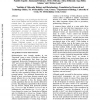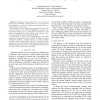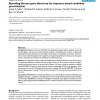TITB
2010
13 years 7 months ago
2010
Progressive loss of the field of vision is characteristic of a number of eye diseases such as glaucoma, a leading cause of irreversible blindness in the world. Recently, there has ...
JBI
2011
13 years 7 months ago
2011
We are developing a set of ontologies that deal with vector-borne diseases and the arthropod vectors that transmit them. For practical reasons (application priorities), we initiat...
BMCBI
2011
13 years 8 months ago
2011
Background: Single Nucleotide Polymorphism (SNP) analysis only captures a small proportion of associated genetic variants in Genome-Wide Association Studies (GWAS) partly due to s...
CARTOGRAPHICA
2010
13 years 10 months ago
2010
For more than a century John Snow's iconic map of an 1854 cholera outbreak in the Broad Street area of Soho, London, has been the very definition of how to discover the sourc...
ITBAM
2010
13 years 11 months ago
2010
A prediction model that exploits the past medical patient history to determine the risk of individuals to develop future diseases is proposed. The model is generated by using the s...
ICPR
2010
IEEE
13 years 12 months ago
2010
IEEE
—Alzheimer’s disease (AD) final is one of the most frequent type of dementia. Currently there is no cure for AD and early diagnosis is crucial to the development of treatments...
ARTMED
2000
14 years 22 days ago
2000
Diagnosis of a disease and its treatment are not separate, one-shot activities. Instead, they are very often dependent and interleaved over time. This is mostly due to uncertainty...
JIB
2007
14 years 24 days ago
2007
In order to improve the accessibility of genomic and proteomic information to medical researchers, we have developed a procedure to link biological information on proteins involve...
BMCBI
2005
14 years 24 days ago
2005
Background: To date, 35 human diseases, some of which also exhibit anticipation, have been associated with unstable repeats. Anticipation has been reported in a number of diseases...
BMCBI
2005
14 years 24 days ago
2005
Background: Regions of interest identified through genetic linkage studies regularly exceed 30 centimorgans in size and can contain hundreds of genes. Traditionally this number is...






